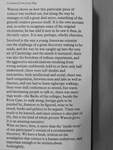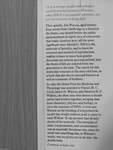1.034.151
kiadvánnyal nyújtjuk Magyarország legnagyobb antikvár könyv-kínálatát

VISSZA
A TETEJÉRE
JAVASLATOKÉszre-
vételek
The Double Helix
A Personal Account of the Discovery of the Structure of DNA
| Kiadó: | Weidenfeld and Nicolson |
|---|---|
| Kiadás helye: | London |
| Kiadás éve: | |
| Kötés típusa: | Varrott keménykötés |
| Oldalszám: | 226 oldal |
| Sorozatcím: | |
| Kötetszám: | |
| Nyelv: | Angol |
| Méret: | 22 cm x 15 cm |
| ISBN: | 297-76042-4 |
| Megjegyzés: | Fekete-fehér fotókkal, illusztrációkkal. |
naponta értesítjük a beérkező friss
kiadványokról
naponta értesítjük a beérkező friss
kiadványokról
Előszó
TovábbFülszöveg
Continued from front flap Watson shows us how this particular piece of science was worked out, but along the way he manages to teli a great deal more, something of the generál creative process itself. It is his own account and, in order to recapture somé of the originál excitement, he has told it now as he saw it then, in the early 1950S. It is not, perhaps, wholly objective. Involved is the way a young American scientist saw the challenge of a great discovery waiting to be made, and the way he was caught up into the very air of Cambridge and the minds it nurtured; there was alsó the boredom of tedious experiment, and the aggressive miscalculations resulting from wrong notions stubbornly held to or facts only half understood; there were self-doubts and insecurities, both intellectual and social; there was hard competition, between men and labs as weil as theories, and one had to learn tightrope walking; there were dull conferences to attend, but warm and fascinating people to talk... TovábbFülszöveg
Continued from front flap Watson shows us how this particular piece of science was worked out, but along the way he manages to teli a great deal more, something of the generál creative process itself. It is his own account and, in order to recapture somé of the originál excitement, he has told it now as he saw it then, in the early 1950S. It is not, perhaps, wholly objective. Involved is the way a young American scientist saw the challenge of a great discovery waiting to be made, and the way he was caught up into the very air of Cambridge and the minds it nurtured; there was alsó the boredom of tedious experiment, and the aggressive miscalculations resulting from wrong notions stubbornly held to or facts only half understood; there were self-doubts and insecurities, both intellectual and social; there was hard competition, between men and labs as weil as theories, and one had to learn tightrope walking; there were dull conferences to attend, but warm and fascinating people to talk to; there was more than work-the Backs of the colleges, beside the River Cam, to walk along, foreign girls to be puzzled by, finances to be figured, wine to be tasted, books and politics to be argued. There was much to be learned, and since science is alsó part of life, this is the kind of whole picture Watson gives. It is an amazing narrative. What we have, then, is more than the 'inside story' of one participant's version of a revolutionary discovery. We have a book, written on the assumption that science is a humán endeavour, and important enough to be written about forthrightly.7í is a strange model and embodies several unusualfeatures. However, since DNA is an unusual substance, we are not hesitant in being bold Thas quietly, Jim Watson, aged twentyfour, wrote from Cambridge to a friend in the States, one month before the public announcement in April 1953 of a discovery that many scientists now call the most significant since MendeFs. DNA is the molecule of heredity, and to know its structure and method of reproduction enables science to know how genetic directions are written and transmitted, how the forms of life are or dered from one generation to the next. The search for this molecular structure is the story told here, in a book that alsó has its unusual features as weil as a measure of boldness. In 1962 the Nobel Prize for Medicine and Physiology was awarded to Francis H. C. Crick, James D. Watson, and Maurice H. F. Wilkins, the three men who almost a decade earlier had worked together, merging data from chemistry, physics, and biology, to solve the structure of DNA-Crick and Watson on the building of a hypothetical model that would conform in all its parts to what Wilkins' X-ray pictufes had already shown of the molecule. The interplay of ideas, temperaments, and circumstances was an especially fortuitous one, since the result was something that, in Watson's words, was too pretty not to be true: the double helix. Continued on back cover Vissza
Témakörök
- Idegennyelv > Idegennyelvű könyvek > Angol > Természettudományok > Biológia
- Idegennyelv > Idegennyelvű könyvek > Angol > Természettudományok > Kémia
- Idegennyelv > Idegennyelvű könyvek > Angol > Természettudományok > Egyéb
- Természettudomány > Kémia > Biokémia
- Természettudomány > Kémia > Idegennyelvű
- Természettudomány > Általános természettudomány > Kutatások, felfedezések
- Természettudomány > Általános természettudomány > Történet
- Természettudomány > Biológia > Biológia, általános > Sejtbiológia
- Természettudomány > Biológia > Biológia, általános > Genetika
- Természettudomány > Biológia > Biológia, általános > Biokémia
- Természettudomány > Biológia > Biológia, általános > Idegennyelvű
- Természettudomány > Általános természettudomány > Idegennyelvű > Angol
James D. Watson
James D. Watson műveinek az Antikvarium.hu-n kapható vagy előjegyezhető listáját itt tekintheti meg: James D. Watson könyvek, művekMegvásárolható példányok
Nincs megvásárolható példány
A könyv összes megrendelhető példánya elfogyott. Ha kívánja, előjegyezheti a könyvet, és amint a könyv egy újabb példánya elérhető lesz, értesítjük.








